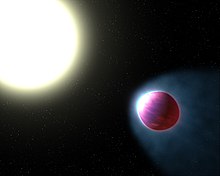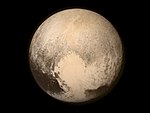astro.wikisort.org - Meteorite
WASP-121b is an extrasolar planet orbiting the star WASP-121.[4][5] WASP-121b is the first exoplanet found to contain water in an extrasolar planetary stratosphere (i.e., an atmospheric layer in which temperatures increase as the altitude increases).[4][5] WASP-121b is in the constellation Puppis,[6] and is about 850 light-years from Earth.[7][4][8]
 Artist's impression of WASP-121b and its host star | |
| Discovery | |
|---|---|
| Discovery date | 2015[1] |
Detection method | Primary Transit[1] |
| Orbital characteristics | |
Semi-major axis | 0.02544 AU (3,806,000 km) |
| Eccentricity | 0.0[1] |
Orbital period (sidereal) | 1.275[1] d |
| Inclination | 87.6°[1] |
| Star | WASP-121 |
| Physical characteristics | |
Mean radius | 1.81[2] RJ |
| Mass | 1.184[1][2] MJ |
| Temperature | 2236+38 −97 K[3] |
In August 2022, this planet and its host star were included among 20 systems to be named by the third NameExoWorlds project.[9]
Characteristics

WASP-121b is a "hot Jupiter" exoplanet with a mass about 1.18 times that of Jupiter and a radius about 1.81 times that of Jupiter.[2][4] The exoplanet orbits WASP-121, its host star, every 1.27 days.[2][4]
In 2019 a work by Hellard et al. discussed the possibility of measuring the Love number of transiting hot Jupiters using HST/STIS. A tentative measurement of for WASP-121b was published in the same work.[10][11]
The planetary orbit is inclined to the equatorial plane of the star by 8.1°.[12]
Atmospheric composition
A spectral survey in 2015 attributed 2,500 °C (4,530 °F), hot[4] stratosphere absorption bands to water molecules, titanium(II) oxide (TiO) and vanadium(II) oxide (VO).[1] Neutral iron was also detected in the stratosphere of WASP-121b in 2020,[13][14] along with neutral chromium and vanadium.[15] The detection claims of titanium(II) oxide (TiO) and vanadium(II) oxide (VO) have since been disproved.[16][17][18][19]
Reanalysis of aggregated spectral data was published in June 2020. Neutral magnesium, calcium, vanadium, chromium, iron, and nickel, along with ionized sodium atoms, were detected. The low quality of available data preclude a positive identification of any molecular species, including water. The atmosphere appears to be significantly out of chemical equilibrium and possibly escaping.[20] The strong atmospheric flows beyond the Roche lobe, indicating ongoing atmosphere loss, were confirmed in late 2020.[12]
In 2021, the planetary atmosphere turned out to be slightly more blue and less absorbing, which may be an indication of planetary weather patterns.[21] By mid-2021, the presence of ions of iron, calcium, chromium, vanadium and calcium in planetary atmosphere was confirmed.[22] In 2022, barium was also detected.[23] By 2022, an absense of titanium in planetary atmosphere was confirmed and attributed to the nightside condensation of the highly refractory Titanium dioxide.[24]
See also
References
- Staff (2015). "Planet WASP-121 b". exoplanet.eu. Retrieved 3 August 2017.
- Staff (2017). "WASP Planets". wasp-planets.net. Retrieved 3 August 2017.
- COMPREHENSIVE ANALYSIS OF TESS FULL ORBITAL PHASE CURVE OF WASP-121b, 2022, arXiv:2202.03504
- Landau, Elizabeth; Villard, Ray (2 August 2017). "Hubble Detects Exoplanet with Glowing Water Atmosphere". NASA. Retrieved 2 August 2017.
- Evans, Thomas M.; et al. (2 August 2017). "An ultrahot gas-giant exoplanet with a stratosphere". Nature. 548 (7665): 58–61. arXiv:1708.01076. Bibcode:2017Natur.548...58E. doi:10.1038/nature23266. PMID 28770846. S2CID 205258293.
- Staff. "Finding the constellation which contains given sky coordinates". djm.cc. Retrieved 3 August 2017.
- Brown, A. G. A; et al. (2016). "Gaia Data Release 1. Summary of the astrometric, photometric, and survey properties". Astronomy and Astrophysics. 595. A2. arXiv:1609.04172. Bibcode:2016A&A...595A...2G. doi:10.1051/0004-6361/201629512. hdl:2445/125903. S2CID 1828208.Gaia Data Release 1 catalog entry
- Greicius, Tony (7 August 2018). "Water Is Destroyed, Then Reborn in Ultrahot Jupiters". NASA. Retrieved 15 November 2018.
- "List of ExoWorlds 2022". nameexoworlds.iau.org. IAU. 8 August 2022. Retrieved 27 August 2022.
- Hellard, Hugo; Csizmadia, Szilárd; Padovan, Sebastiano; Sohl, Frank; Rauer, Heike (2020). "HST/STIS capability for Love number measurement of WASP-121b". The Astrophysical Journal. 889 (1): 66. arXiv:1912.05889. Bibcode:2020ApJ...889...66H. doi:10.3847/1538-4357/ab616e. S2CID 209324250.
- waspplanets (19 December 2019). "The tidal shape of the exoplanet WASP-121b". WASP Planets. Retrieved 20 January 2020.
- Atmospheric Rossiter-McLaughlin effect and transmission spectroscopy of WASP-121b with ESPRESSO, 2020, arXiv:2011.01245
- Gibson, Neale P.; Merritt, Stephanie; Nugroho, Stevanus K.; Cubillos, Patricio E.; de Mooij, Ernst J. W.; Mikal-Evans, Thomas; Fossati, Luca; Lothringer, Joshua; Nikolov, Nikolay; Sing, David K.; Spake, Jessica J.; Watson, Chris A.; Wilson, Jamie (2020). "Detection of Fe I in the atmosphere of the ultra-hot Jupiter WASP-121b, and a new likelihood-based approach for Doppler-resolved spectroscopy". Monthly Notices of the Royal Astronomical Society. 493 (2): 2215. arXiv:2001.06430. Bibcode:2020MNRAS.493.2215G. doi:10.1093/mnras/staa228. S2CID 210714233.
- Cabot, Samuel H. C.; Madhusudhan, Nikku; Welbanks, Luis; Piette, Anjali; Gandhi, Siddharth (2020). "Detection of neutral atomic species in the ultra-hot jupiter WASP-121b". Monthly Notices of the Royal Astronomical Society. 494 (1): 363–377. arXiv:2001.07196. Bibcode:2020MNRAS.494..363C. doi:10.1093/mnras/staa748. S2CID 210838889.
- Ben-Yami, Maya; Madhusudhan, Nikku; Cabot, Samuel H. C.; Constantinou, Savvas; Piette, Anjali; Gandhi, Siddharth; Welbanks, Luis (2020). "Neutral Cr and V in the Atmosphere of Ultra-hot Jupiter WASP-121 B". The Astrophysical Journal. 897 (1): L5. arXiv:2006.05995. Bibcode:2020ApJ...897L...5B. doi:10.3847/2041-8213/ab94aa. S2CID 219573825.
- Evans, Thomas M.; Sing, David K.; Kataria, Tiffany; Goyal, Jayesh; Nikolov, Nikolay; Wakeford, Hannah R.; Deming, Drake; Marley, Mark S.; Amundsen, David S.; Ballester, Gilda E.; Barstow, Joanna K. (August 2017). "An ultrahot gas-giant exoplanet with a stratosphere". Nature. 548 (7665): 58–61. doi:10.1038/nature23266. ISSN 1476-4687.
- Mikal-Evans, Thomas (27 June 2019). "An emission spectrum for WASP-121b measured across the 0.8–1.1 μm wavelength range using the Hubble Space Telescope". Monthly Notices of the Royal Astronomical Society. 488: 2222–2234 – via OUP.
- Merritt, S. R.; Gibson, N. P.; Nugroho, S. K.; Mooij, E. J. W. de; Hooton, M. J.; Matthews, S. M.; McKemmish, L. K.; Mikal-Evans, T.; Nikolov, N.; Sing, D. K.; Spake, J. J. (1 April 2020). "Non-detection of TiO and VO in the atmosphere of WASP-121b using high-resolution spectroscopy". Astronomy & Astrophysics. 636: A117. doi:10.1051/0004-6361/201937409. ISSN 0004-6361.
- Mikal-Evans, Thomas; Sing, David K.; Kataria, Tiffany; Wakeford, Hannah R.; Mayne, Nathan J.; Lewis, Nikole K.; Barstow, Joanna K.; Spake, Jessica J. (2020). "Confirmation of water emission in the dayside spectrum of the ultrahot Jupiter WASP-121b". Monthly Notices of the Royal Astronomical Society. 496 (2): 1638–1644. arXiv:2005.09631. Bibcode:2020MNRAS.496.1638M. doi:10.1093/mnras/staa1628. S2CID 218684532.
- Hoeijmakers, H. J.; Seidel, J. V.; Pino, L.; Kitzmann, D.; Sindel, J. P.; Ehrenreich, D.; Oza, A. V.; Bourrier, V.; Allart, R.; Gebek, A.; Lovis, C.; Yurchenko, S. N.; Astudillo-Defru, N.; Bayliss, D.; Cegla, H.; Lavie, B.; Lendl, M.; Melo, C.; Murgas, F.; Nascimbeni, V.; Pepe, F.; Ségransan, D.; Udry, S.; Wyttenbach, A.; Heng, Kevin (2020), Hot Exoplanet Atmospheres Resolved with Transit Spectroscopy (HEARTS) IV. A spectral inventory of atoms and molecules in the high-resolution transmission spectrum of WASP-121 b, arXiv:2006.11308
- Gemini/GMOS Optical Transmission Spectroscopy of WASP-121b:signs of variability in an ultra-hot Jupiter, 2021, arXiv:2103.05698
- An inventory of atomic species in the atmosphere of WASP-121b using UVES high-resolution spectroscopy, 2021, arXiv:2106.15394
- Detection of barium in the atmospheres of the ultra-hot gas giants WASP-76b and WASP-121b, 2022, arXiv:2210.06892
- The Mantis Network III: A titanium cold-trap on the ultra-hot Jupiter WASP-121 b., 2022, arXiv:2210.12847
External links
- SuperWASP Wide Angle Search for Planets: The Planets, SuperWASP.
- Pultarova, Tereza (3 August 2017). "Hubble Telescope Detects Stratosphere on Huge Alien Planet". space.com. Retrieved 3 August 2017.
Другой контент может иметь иную лицензию. Перед использованием материалов сайта WikiSort.org внимательно изучите правила лицензирования конкретных элементов наполнения сайта.
WikiSort.org - проект по пересортировке и дополнению контента Википедии



